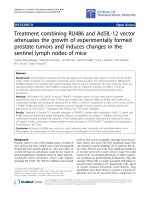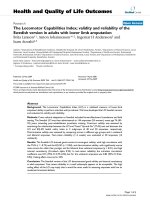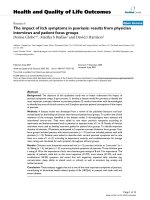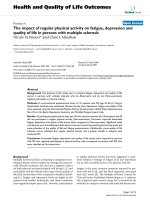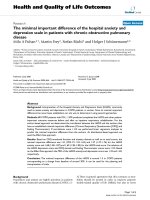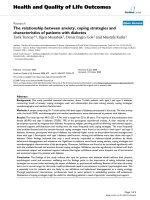báo cáo hóa học:" The mangled extremity and attempt for limb salvage" docx
Bạn đang xem bản rút gọn của tài liệu. Xem và tải ngay bản đầy đủ của tài liệu tại đây (582.65 KB, 6 trang )
BioMed Central
Page 1 of 6
(page number not for citation purposes)
Journal of Orthopaedic Surgery and
Research
Open Access
Research article
The mangled extremity and attempt for limb salvage
Anastasios V Korompilias*
1
, Alexandros E Beris
1
, Marios G Lykissas
1
,
Marios D Vekris
1
, Vasileios A Kontogeorgakos
1
and Panayiotis N Soucacos
2
Address:
1
Department of Orthopaedic Surgery, University of Ioannina School of Medicine, Ioannina, Greece and
2
Department of Orthopaedic
Surgery, University of Athens School of Medicine, Athens, Greece
Email: Anastasios V Korompilias* - ; Alexandros E Beris - ; Marios G Lykissas - ;
Marios D Vekris - ; Vasileios A Kontogeorgakos - ;
Panayiotis N Soucacos -
* Corresponding author
Abstract
Background: The decision, whether to amputate or reconstruct a mangled extremity remains the
subject of extensive debate since multiple factors influence the decision.
Methods: Sixty three patients with high energy extremity trauma and attempts at limb salvage
were retrospectively reviewed. We analyzed 10 cases of massive extremity trauma where there
was made an attempt to salvage limbs, although there was a controversy between salvage and
amputation.
Results: All of the patients except one had major vascular injury and ischemia requiring repair.
Three patients died. All of the remaining patients were amputated within 15 days after the salvage
procedure, mainly because of extremity sepsis. Seven patients required treatment at the intensive
care unit. All patients had at least 2 reconstruction procedures and multiple surgical debridements.
Conclusion: The functional outcome should be considered realistically before a salvage decision
making for extremities with indeterminate prognosis.
Background
Occasionally the surgeon is confronts an extremity that is
so mangled that salvage is questionable, and a specific
answer is almost impossible. Undoubtedly, amputation
of a mangled extremity is an unpleasant and devastating
process for the patient and the surgeon. On the other
hand, prolonged unsuccessful attempts for salvage are
highly morbid, costly, and sometimes lethal [1,2]. The
decision between amputation and reconstruction remains
a matter of controversy [3,4]. Several factors require con-
sideration, such as the extent and severity of vascular
injury, bone and soft tissue destruction, the type and dura-
tion of limb ischemia, patient's age and previous health
status, and the presence of concomitant organ injuries.
Efforts should be directed not just to salvage a limb, but to
produce a functional painless extremity with at least pro-
tective sensation [5,6].
The purpose of this study is to present the magnitude of
this important clinical dilemma since the decision
between salvage and amputation is vague, and to deter-
mine if the clinician will be able to predict amputation in
borderline patients using the standard predictive scoring
systems.
Published: 13 February 2009
Journal of Orthopaedic Surgery and Research 2009, 4:4 doi:10.1186/1749-799X-4-4
Received: 7 January 2008
Accepted: 13 February 2009
This article is available from: />© 2009 Korompilias et al; licensee BioMed Central Ltd.
This is an Open Access article distributed under the terms of the Creative Commons Attribution License ( />),
which permits unrestricted use, distribution, and reproduction in any medium, provided the original work is properly cited.
Journal of Orthopaedic Surgery and Research 2009, 4:4 />Page 2 of 6
(page number not for citation purposes)
Methods
Over a 9-year period from 1996 to 2005, 63 patients with
high energy extremity trauma and attempts at limb sal-
vage were retrospectively reviewed. The Mangled Extrem-
ity Syndrome Index (MESI) and the Mangled Extremity
Severity Score (MESS) were used for scoring both upper as
well as lower extremity injuries [7,8]. Although MESS was
not developed for the upper extremity injuries, the
authors included MESS scoring for making a comparison
with MESI. Fifty three patients (84%) ended the postoper-
ative course without any major complication. From the
rest ten cases (16%) of massive extremity trauma which
had attempts for limb salvage, seven patients (11%)
underwent delayed amputation and three patients (5%)
died from complications related directly or indirectly to
major surgical procedures that followed (Table 1). In
these ten cases, the decision between salvage and amputa-
tion was not clear. Both scoring systems provided limited
diagnostic benefit. Thus, we had an extensive discussion
with the patient and his relatives, in order to point out
that any attempt at limb salvage might result to major
complications and probably a delayed amputation. In
addition, even with salvage severe disability was expected.
Nine patients were males and one female with ages rang-
ing from 8 to 75 years (mean; 27 years). In all cases, the
high-energy massive extremity trauma was caused by a
combination of crushing and avulsive injury. No guillo-
tine injuries were encountered in this group. The mecha-
nism of injury was labor-related accidents in six patients
and motor vehicle accidents in four patients. Gustilo type
IIIC fractures (with extensive soft tissue damage and
major vascular injury and ischemia requiring repair) were
present in nine patients (Figure 1), while one patient had
Gustilo type IIIB injury. Seven fractures concerned the
lower extremity and three the upper extremity. One
patient also had a contralateral transtibial traumatic
amputation.
Four patients had concomitant injuries. These included
two chest injuries, two head injuries, and one contralat-
eral humeral fracture. None of these injuries was consid-
Table 1: Profile of patients with mangled extremity
Patient Gender Age (years) Mechanism of
Injury
Upper/or
Lower
Extremity
Ischemia time MESI Score MESS Score Results
1 F 75 MVA Distal femur 8 h 15 6 Death – Multiple
organ failure 24 h
postop
2 M 29 Farmyard injury Proximal tibia 7 h 16 6 Sepsis –
Amputation 2
weeks postop
3 M 25 MVA Knee joint 6.5 h 15 6 Death –
Pulmonary
embolism 5 days
postop
4 M 47 Industrial Proximal tibia 7.5 h 16 6 Death – Sepsis 2
weeks postop
5 M 11 Farmyard injury Elbow joint 11 h 20 8 Sepsis –
Amputation 7
days postop
6 M 25 Industrial Distal humerus 8.5 h 20 6 Sepsis –
Amputation 10
days postop
7 M18 MVA Ankle 6 h 20 8 Sepsis –
Amputation 5
days postop
8 M 8 Farmyard injury Ankle 9 h 21 8 Vein/Artery
thrombosis –
Amputation 3
days postop
9 M 25 MVA Middle femur - 20 7 Compartment
syndrome –
Amputation 11
days postop
10 M 17 Farmyard injury Proximal
humerus
7.5 h 20 8 Vein/Artery
thrombosis –
Amputation 3
days postop
MVA: Motor Vehicle Accident
Journal of Orthopaedic Surgery and Research 2009, 4:4 />Page 3 of 6
(page number not for citation purposes)
ered as life-threatening. However, in these four patients
with a borderline score limp salvage was also attempted.
The time period between the injury and arrival to the
operating theater was 6.5 hours. Revascularization was
achieved from 6 to 11 hours (mean time; 7.8 hours)
(Table 1). Fracture reduction and stabilization was
achieved by external fixation in order to decrease the
ischemia time, in seven patients with lower extremity
injuries, and internal fixation (plate and screws) in three
patients with upper extremity injuries. In two patients,
temporary arterial shuntings before skeletal fixation was
performed.
After bone fixation vascular reconstruction was done
using microsurgical techniques. Reconstruction for vascu-
lar injury was performed with reverse saphenous vein graft
from the contralateral lower limb in eight patients. When
both arteries of the extremity were injured, particularly
those involving the tibia, both arteries were repaired. No
primary repair of the injured nerves was performed.
Fasciotomies were not required because the majority of
patients had extensive soft tissue defects. Only one patient
with Gustilo type IIIB fracture of the femur underwent
delayed fasciotomy.
Results
In the group of patients who successfully salvaged, the
mean MESI and MESS score was 15.5 and 4.8, respec-
tively. However, in the group of patients who underwent
secondary amputation or had a fatal outcome both scor-
ing systems varied in identifying a nonviable extremity. In
this group, mean MESI and MESS score was 18.3 and 7,
respectively.
Although there was no intraoperative death, three patients
(5%) died postoperatively. One death was related with
massive pulmonary embolism 5 days postoperatively in a
40-year-old female patient with severe Gustilo type IIIC
injury of the tibia (with rupture of the popliteal artery
above the trifurcation level). A second female patient died
within 48 hours of admission. A severe crush injury from
motor pedestrian accident resulted in an open Gustilo
type IIIC fracture of the right distal femur. The patient
underwent surgical repair of both vascular and bony inju-
ries. She also had a contralateral transtibial traumatic
amputation. Twenty four hours later she developed
myoglobinuria, renal failure, coagulopathy, and multiple
organ failure. The third death was due to severe sepsis two
weeks after attempting salvage in a patient with Gustilo
type IIIC fracture of the tibia.
All the remaining patients (11%) required secondary
amputation within 15 days after attempted salvage proce-
dure, because of extensive muscular necrosis (5 patients)
and severe extremity sepsis manifested by positive tissue
and blood cultures (2 patients). The amputation levels
were one above the knee, two below the knee, one Syme's
amputation, and three above the elbow amputations. In
all cases patient's agreement to this plane of care was
obtained after detailed explanation of the new clinical sta-
tus and all possible alternatives. For these seven border-
line patients, amputation was predicted by MESI in 6
patients and by MESS in 5 patients. From the 63 patients,
53 were successfully operated. According to MESI 50
patients were expected to be salvaged and by MESS 47
patients.
Seven patients (11%) required treatment at the intensive
care unit from 3 to 41 days. All patients, on the average,
were hospitalized for 55 days (range; 30 to 106 days), and
had at least 2 reconstruction procedures and multiple sur-
gical debridements. Coverage procedures were done with
split-thickness skin grafts in 6 patients and free flap trans-
fer in one patient.
One patient with below knee amputation was able to
return to work. One patient with above the knee amputa-
tion and one patient with above the elbow amputation
were retired on a disability pension. Most patients experi-
ence some degree of postraumatic depression and have
difficulty to handle the emotional aspects of delayed
amputation.
Eighteen-year-old male patient with severe Gustilo type IIIC injury of the ankle after a motorcycle accidentFigure 1
Eighteen-year-old male patient with severe Gustilo
type IIIC injury of the ankle after a motorcycle acci-
dent. An initial attempt for limb salvage with anastomosis of
the posterior tibial artery was followed by delayed amputa-
tion 5 days postoperatively due to severe sepsis.
Journal of Orthopaedic Surgery and Research 2009, 4:4 />Page 4 of 6
(page number not for citation purposes)
Discussion
The application of microsurgical techniques has been
responsible for significant success in terms of extremity
salvage and secondary reconstruction [5,6,9]. However,
an attempt for limb salvage should not be made on the
basis of what is technically possible [10]. Expertise in, and
enthusiasm for, microvascular surgery may lead to costly,
highly morbid, and sometimes lethal attempts at preser-
vation of disfunctioned limbs [11,12]. Hansen [13] char-
acterized this approach as triumphs over reason.
Patients who initially confront a threatening injury often
focus on the loss of the extremity rather than on the con-
sequences of the limb salvage. Patients undergoing this
procedure, will require more complex operations, longer
hospitalization, and will suffer more complications than
primary amputees. Tornetta and Olson reported on
patients who have undergone multiple operations over a
period of several years to "heroically" save a leg only to
render the patient depressed, divorced, unemployed, and
significantly disabled [14]. Unfortunately, "salvage" of a
mangled extremity is no guarantee of functionality or
employability. It is crucial for the patient and his family to
realize that both salvage and early amputation by no
means can reassure the patient that will return to a previ-
ous normal, pain free extremity [15].
In most of the patients, sepsis and other infection compli-
cations may be so severe and persistent that ultimately
secondary amputation is required. Bondurant et al. [1]
compared primary versus delayed amputations in 43
cases, including 14 primary and 29 delayed ones. Impor-
tant findings included 6 deaths from sepsis in delayed
amputation group compared with none in the early
amputation group. The data from our study concur with
this data that the delayed amputation was associated with
a high risk of extremity sepsis and mortality. It should be
clarified that amputation does not necessarily reflect a
failure of management but might be the first step to a suc-
cessful rehabilitation [16].
Although cost should not be a major deciding factor for
limb salvage, many patients may be devastated by the
cost, not only of medical bills but also of time off work
[1]. Fainhurst [17] retrospectively compared the func-
tional outcome of patients who sustained traumatic
below knee amputations with that in patients who under-
went limb salvage of Gustilo type III open tibial fractures.
All patients in the early amputation group returned to
work within 6 months of injury, while those who under-
went late amputation and salvage returned to work an
average of 36 and 18 months after injury, respectively. The
authors recommend an early amputation when con-
fronted with borderline salvageable tibial injury. Georgi-
adis et al. [18] estimated the quality of life by using a
questionnaire regarding life satisfaction and disability.
Although 35% of the salvage group lost the follow-up, sig-
nificantly more patients who had had limb salvage con-
sidered themselves severely disabled and had more
problems with the performance of occupational and rec-
reational activities. On the other hand, most patients dealt
with the emotional aspects of amputation in a more pos-
itive emotional way of delayed amputation or prolonged
and complicated limb salvage [19].
In a recent study, Karladani et al. [20] retrospectively
reviewed 18 patients with tibial shaft fractures associated
with extensive soft tissue damage. All patients were
assessed for their physical function, psychological status,
and general function. Almost 90% of the patients were
satisfied with the salvage procedure, and if they would be
reinjured similarly, 88% of them would prefer limb sal-
vage procedures before amputation. Limitation of the
study was, however, the small group size. In contrary,
quite a lot of studies have demonstrated that early ampu-
tation on the basis of appropriate criteria, improved func-
tion and limited the long-term complications [1,2,13].
Several predictive scoring systems have been developed to
aid the decision process for limb salvation or amputation.
However, almost all classification systems were assessed
on retrospective studies, with small number of patients,
and patients with known outcomes. In addition, all of the
scoring systems are only applied at the time of the initial
evaluation, and they do not provide any guiding princi-
ples for the decision making in the further treatment
course. Another major drawback is that all of the scoring
systems apply to specifically for mangled lower extremi-
ties, and none of the current classification systems were
specifically designed for use in the upper extremity. It is
obvious, that a mangled upper extremity has a much
greater effect on the patient's life than does a mangled
lower extremity. Thus, the criteria for salvage of the upper
extremity are quite different from those for salvage of the
lower extremity for better salvage functional results and
poorer functional prognosis after amputation in the upper
extremity. Dirschl and Dahners [11] recommend that
mangled upper extremities should be treated on a case-by-
case basis and the use of scoring systems should not sup-
plant the surgeon's clinical judgment.
The most widely described scoring systems are: the Man-
gled Extremity Syndrome Index (MESI) [7], the Predictive
Salvage index (PSI) [9], the Mangled Extremity Severity
Score (MESS) [8], and the Nerve Injury, Ischemia, Soft-
Tissue Injury, Skeletal Injury, Shock, and Age of Patient
(NISSSA) Score [21]. Each scoring system has a "cutoff
point". If the total score exceeds the critical "cutoff point"
primary or early amputation should be considered. How-
ever, these scoring systems have been criticized as being
Journal of Orthopaedic Surgery and Research 2009, 4:4 />Page 5 of 6
(page number not for citation purposes)
too complex and subjective with large variations in inter-
observer classification of mangled extremity, and as
expected none of them is accurate in all cases [22]. Even
among experienced surgeons there is disagreement
regarding the criteria of these scoring systems, which can-
not be used with confidence in clinical practice, because
their use has not led to specific outcomes.
Although scoring systems may be helpful, the patient's
status cannot simply be summarized by a score number. A
closer look reveals that many questions remain unan-
swered. These systems fail to consider factors related to the
patient's quality of life, pain, occupation, age, wishes,
social support system, family status, and financial
resources. The training and experience of the surgical team
may also influence the decision to amputate or recon-
struct. Although these considerations are more subjective,
undoubtedly they are very important. The true measure of
successful limb salvage lies in the overall function and sat-
isfaction of the patient. In our series, the main reason of
delayed amputation, despite the initial indication for
limb salvage according to MESI and MESS scoring sys-
tems, was physician's choice in relation to patient's condi-
tion and psychology.
The Lower Extremity Assessment Project (LEAP) is a pro-
spective cohort of patients undergoing limb salvage as
compared with those undergoing early amputation [23].
The predictive scoring systems were evaluated to deter-
mine whether they were specific, sensitive, and discrimi-
natory in terms of guiding the performance of an early
amputation versus limb salvage. Unfortunately, the anal-
ysis did not validate the clinical utility of any scales and
could not recommend an existing index for determining
when to perform amputation versus limb salvage. Injury
factors that influence the decision to salvage limbs are
muscle injury, absence of sensation, arterial injury, and
vein injury. Patient's personal factors played much a less
significant role; the most significant of these were alcohol
consumption and patient's socioeconomic status [15].
In the present study, both lower and upper extremities
injuries were scored using MESI and MESS. The "cutoff
point" was 20 and 7, respectively. Among these scoring
systems, MESS is the only that derives from a study with a
prospective validation trial. The authors used this system
because of its simplicity and its ability to score at the time
of the initial evaluation without direct observation in the
operating room. Although MESS was not designed to
score upper extremity injuries, it has been shown that it
has 100% specificity and 100% positive predictive value
in these injuries [24]. Weak point of this scoring system is
its limited sensitivity and negative predictive value when
compared to MESI for the upper extremities [24]. In our
study, MESI was more accurate than MESS to predict both
amputation if amputation was predicted and salvage if
salvage was predicted.
Conclusion
As a majority of cases represent a "gray zone" of unpredict-
able prognosis, and borderline cases are a dilemma, the
decision to amputate or not amputate should not always
be made during the initial evaluation. Although scoring
systems and "cutoff points" are useful, the final decision
for limb salvage should be based on team experience,
technical skills, multidisciplinary consultation, tertiary-
care facility, and the profile of the patient. Scoring systems
should be used only as guides to supplement the sur-
geon's clinical judgment and experience.
Consent
Written informed consent was obtained from the patients
for publication of their cases and accompanying images.
A copy of the written consent is available for review by the
Editor-in-Chief of this journal.
Competing interests
The authors declare that they have no competing interests.
Authors' contributions
All authors contributed equally to this work. MGL and
AVK participated in the design of the study and drafted the
manuscript. MDV participated in the design of the study.
VAK performed the statistical analysis. AEB and PNS con-
ceived of the study, and participated in its design and
coordination and helped to draft the manuscript
Anastasios Korompilias has had the main responsibility
for the study and manuscript preparation. All authors read
and approved the final manuscript.
References
1. Bondurant FJ, Cotler HB, Buckle R, Miller-Crotchett P, Browner BD:
The medical and economic impact of severely injured lower
extremities. J Trauma 1988, 28:1270-1273.
2. Hansen ST Jr: Overview of the severely traumatized lower
limb. Reconstruction versus amputation. Clin Orthop Relat Res
1989, 243:17-19.
3. MacKenzie EJ, Bosse MJ, Kellam JF, Burgess AR, Webb LX,
Swiontkowski MF, Sanders R, Jones AL, McAndrew MP, Patterson B,
McCarthy ML, Rohde CA, LEAP Study Group: LEAP Study Group.
Factors influencing the decision to amputate or reconstruct
after high-energy lower extremity trauma. J Trauma 2002,
52:641-649.
4. Xenakis TA, Beris AE, Chrysovitsinos JP, Mavrodontidis AN, Vekris
MD, Zacharis K, Soucacos PN: Nonviable injuries of the tibia.
Acta Orthop Scand 1995:23-26.
5. Lange RH: Limb reconstruction versus amputation decision
making in massive lower extremity trauma. Clin Orthop 1989,
243:92-99.
6. Soucacos PN, Beris AE, Xenakis TA, Malizos KN, Vekris MD: Open
type IIIB and IIIC fractures treated by an orthopaedic micro-
surgical team. Clin Orthop Relat Res 1995, 314:59-66.
7. Gregory RT, Gould RJ, Peclet M, Wagner JS, Gilbert DA, Wheeler JR,
Snyder SO, Gayle RG, Schwab CW: The mangled extremity syn-
drome (M.E.S.): A severity grading system for multisystem
injury of the extremity. J Trauma 1985, 25:1147-1150.
Publish with BioMed Central and every
scientist can read your work free of charge
"BioMed Central will be the most significant development for
disseminating the results of biomedical research in our lifetime."
Sir Paul Nurse, Cancer Research UK
Your research papers will be:
available free of charge to the entire biomedical community
peer reviewed and published immediately upon acceptance
cited in PubMed and archived on PubMed Central
yours — you keep the copyright
Submit your manuscript here:
/>BioMedcentral
Journal of Orthopaedic Surgery and Research 2009, 4:4 />Page 6 of 6
(page number not for citation purposes)
8. Johansen K, Daines M, Howey T, Helfet D, Hansen ST Jr: Objective
criteria accurately predict amputation following lower
extremity trauma. J Trauma 1990, 30:568-572.
9. Howe HR Jr, Poole GV Jr, Hansen KJ, Clark T, Plonk GW, Koman LA,
Pennell TC: Salvage of lower extremities following combined
orthopedic and vascular trauma. A predictive salvage index.
Am Surg 1987, 53:205-208.
10. Heitmann C, Levin LC: The orthoplastic approach for manage-
ment of the severely traumatized foot and ankle. J Trauma
2003, 54:379-390.
11. Dirschl DR, Dahners LE: The mangled extremity: when should
it be amputated? J Am Acad Orthop Surg 1996, 4:182-190.
12. Tomaino MM, Bowen CW: Unsatisfactory outcome after lower
limb salvage: decision making pitfalls. Am J Orthop 1998,
27:526-529.
13. Hansen ST Jr: The type-IIIC tibial fracture: Salvage or amputa-
tion. J Bone Joint Surg Am 1987, 69:799-800.
14. Tornetta P 3rd, Olson SA: Amputation versus limb salvage. Instr
Course Lect 1997, 46:511-518.
15. MacKenzie EJ, Bosse MJ, Pollak AN, Webb LX, Swiontkowski MF, Kel-
lam JF, Smith DG, Sanders RW, Jones AL, Starr AJ, McAndrew MP,
Patterson BM, Burgess AR, Castillo RC: Long-term persistence of
disability following severe lower-limb trauma. Results of a
seven-year follow-up. J Bone Joint Surg Am 2005, 87:1801-1809.
16. Seiler JG 3rd, Richardson JD: Amputation after extremity injury.
Am J Surg 1986, 152:260-264.
17. Fairhurst MJ: The function of below-knee amputee versus the
patient with salvaged grade III tibial fracture. Clin Orthop Relat
Res 1994, 301:227-232.
18. Georgiadis GM, Behrens FF, Joyce MJ, Earle AS, Simmons AL: Open
tibial fractures with severe soft-tissue loss. Limb salvage
compared with below-the-knee amputation. J Bone Joint Surg
Am 1993, 75:1431-1441.
19. Pinzur MS, Pinto MA, Schon LC, Smith DG: Controversies in
amputation surgery. Instr Course Lect 2003, 52:445-451.
20. Karladani AH, Granhed H, Fogdestam I, Styf J: Salvaged limbs after
tibial shaft fractures with extensive soft tissue injury: A
biopychological function analysis. J Trauma 2001, 50:60-64.
21. McNamara MG, Heckman JD, Corley FG: Severe open fractures
of the lower extremity: A retrospective evaluation of the
Mangled Extremity Severity Score (MESS). J Orthop Trauma
1994, 8:81-87.
22. Hiatt MD, Farmer JM, Teasdall RD: The decision to salvage or
amputate a severely injured limb. J South Orthop Assoc 2000,
9:72-78.
23. Bosse MJ, MacKenzie EJ, Kellam JF, Burgess AR, Webb LX,
Swiontkowski MF, Sanders RW, Jones AL, McAndrew MP, Patterson
BM, McCarthy ML, Cyril JK: A prospective evaluation of the clin-
ical utility of the lower-extremity injury-severity scores. J
Bone Joint Surg Am 2001, 83:3-14.
24. Durham RM, Mistry BM, Mazuski JE, Shapiro M, Jacobs D: Outcome
and utility of scoring systems in the management of the
mangled extremity. Am J Surg 1996, 172:569-574.



